Novel Method for Failure Modes Detection in UV-Cured Clear Coated Polymer for Automotive Interior Mechatronic Devices
Abstract
1. Introduction
2. Materials and Methods
2.1. New Methodology for Failure Modes Detection of Polymer Parts
2.2. Materials and Process Specifications
3. Results and Discussions
3.1. Results of the Proposed Methodology Applied on the Automotive Polymeric Component
3.2. Design of the Experiments Results
3.3. Failure Modes and Mechanism Studies
4. Conclusions
- The development of coating systems is a necessity based on the fact that many polymers are difficult to coat. There is a need for good surface quality for UV-coated plastic parts used in automotive interior mechatronic devices.
- The methodological checking after each process step is recommended in order to catch the known or not-known defects and to understand their evolutions and/or influences due to all parameter changes.
- Support of the specialists in development of the cause–effect factor relationship for each type of not-yet-known defects is also recommended.
- The surface defects such as fish-eye defects can occur within UV-cured clear coating process or due to mold contamination with either oil or silicone compounds. The mechanism of generation of this defect is based on the difference in surface tension between the contaminant and the coated surface, with molecules starting to migrate towards the surface of the coating.
- The root cause analysis started from the very beginning, from the injection molding tools. After deep analysis of both parts of the tool, some traces were detected in link with an O-ring that could have a possible effect; escape pressured burned oil in time of the molding cycle and contaminated the structure of the plastic part in that window area. As a result, in order to prevent this type of defect from occurring, action must be taken to prevent contamination. There are several methods to clean the substrate, such as: wiping with a solvent using a rag, or in the automatic coating line using carbon ice, ionized air.
- However, there can be different ways of contamination; some of them also refer to the plastic injection molding processes and the way the part is obtained. If the mold is cooled with oil, there is always the risk that the oil can escape through the seals and contaminate the amorphous structure of the injected material. Additionally, the oil lubrication of the moving parts of the injection molding machine could be a possible cause of contamination, as it may not be sufficiently cleaned before application of the UV-cured clear lacquer. Handling of parts at the plastics injection molding shop, intermediate storage, and dragging them onto the coating line can contaminate and lead to the occurrence of surface defects.
- A future research direction would be to investigate and fit the proposed method for detecting failure modes in UV-cured clear-coated composite parts obtained by the autoclave curing process.
Author Contributions
Funding
Institutional Review Board Statement
Informed Consent Statement
Data Availability Statement
Acknowledgments
Conflicts of Interest
References
- Wilke, G.; Ortmeier, J. Coatings for Plastics; Vincentz Network: Berlin, Germany, 2012. [Google Scholar]
- Akafuah, N.K.; Poozesh, S.; Salaimeh, A.; Patrick, G.; Lawler, K.; Saito, K. Evolution of the Automotive Body Coating Process—A Review. Coatings 2016, 6, 24. [Google Scholar] [CrossRef]
- Morel, P.; Feng, L.; Benhamida, N.; Denning, W.; Frye, B.; Detwiler, A.T.; Baker, L.T.; Bhattacharya, D. Advances in scratch char-acterization of automotive clear coats. In Characterization of Minerals, Metals, and Materials; Springer: Cham, Switzerland, 2019; pp. 211–224. [Google Scholar] [CrossRef]
- Cuevas, J.M.; Cobos, R.; Germán, L.; Sierra, B.; Laza, J.M.; Vilas-Vilela, J.L. Enhanced mar/scratch resistance in automotive clear coatings by modifying cross linked polyurethane network with branched flexible oligomers. Prog. Org. Coat. 2022, 163, 106668. [Google Scholar] [CrossRef]
- Rungwasantisuka, A.; Raibhub, S. Spray coating process variable and property analysis of UV-curable polyurethane acrylate coating on polycarbonate substrate. Prog. Org. Coat. 2015, 89, 132–142. [Google Scholar] [CrossRef]
- Akhtar, S.; Tandiya, A.; Moussa, M.; Tarry, C. An Efficient Automotive Paint Defect Detection System. Adv. Sci. Technol. Eng. Syst. J. 2019, 4, 171–182. [Google Scholar] [CrossRef][Green Version]
- Vieira, A.L.N.; Campilho, R.D.S.G.; Silva, F.J.G.; Ferreira, L.P. Increasing the Environmental Sustainability of an Over-Injection Line for the Automotive Component Industry. Sustainability 2021, 13, 12692. [Google Scholar] [CrossRef]
- Torres-Alba, A.; Mercado-Colmenero, J.M.; Caballero-Garcia, J.D.D.; Martin-Doñate, C. Application of New Triple Hook-Shaped Conformal Cooling Channels for Cores and Sliders in Injection Molding to Reduce Residual Stress and Warping in Complex Plastic Optical Parts. Polymers 2021, 13, 2944. [Google Scholar] [CrossRef]
- Farotti, E.; Natalini, M. Injection molding. Influence of process parameters on mechanical properties of polypropylene polymer. A first study. Procedia Struct. Integr. 2018, 8, 256–264. [Google Scholar] [CrossRef]
- Ozcelik, B.; Ozbay, A.; Demirbas, E. Influence of injection parameters and mold materials on mechanical properties of ABS in plastic injection molding. Int. Commun. Heat Mass Transf. 2010, 37, 1359–1365. [Google Scholar] [CrossRef]
- Ardebili, H.; Zhang, J.; Pecht, M. Encapsulation Technologies for Electronic Applications; William Andrew: New York, NY, USA, 2018. [Google Scholar]
- Moayyedian, M.; Dinc, A.; Mamedov, A. Optimization of Injection-Molding Process for Thin-Walled Polypropylene Part Using Artificial Neural Network and Taguchi Techniques. Polymers 2021, 13, 4158. [Google Scholar] [CrossRef]
- Chen, S.-C.; Su, H.; Mathew, J.J.; Gunawan, H.; Huang, C.-W.; Feng, C.-T. An Investigation to Reduce the Effect of Moisture on Injection-Molded Parts through Optimization of Plasticization Parameters. Appl. Sci. 2022, 12, 1410. [Google Scholar] [CrossRef]
- Moon, S.W.; Seo, J.; Seo, J.-H.; Choi, B.-H. Scratch Properties of Clear Coat for Automotive Coating Comprising Molecular Necklace Cross linkers with Silane Functional Groups for Various Environmental Factors. Polymers 2021, 13, 3933. [Google Scholar] [CrossRef]
- Biçen, A.; Güvenç, N. Investigation of Crater Formation on Coatings via Combination of SEM-EDX and FT-IR Microscopy. J. Sci. Technol. 2021, 14, 595–604. [Google Scholar] [CrossRef]
- Czachor-Jadacka, D.; Pilch-Pitera, B. Progress in development of UV curable powder coatings. Prog. Org. Coat. 2021, 158, 106355. [Google Scholar] [CrossRef]
- Ünlükal, C.; Şenel, M.; Şenel, B. Risk Assessment with Failure Mode and Effects Analysis and Grey Relational Analysis Methodin Plastic Injection Process. In Proceedings of the ITM Web of Conferences, Tunceli, Turkey, 17 October 2018; Volume 22, p. 01023. [Google Scholar] [CrossRef]
- Dabous, A.A.; Ibrahim, F.; Feroz, S.; Alsyouf, I. Integration of failure mode, effects, and criticality analysis with multi-criteria decision-making in engineering applications: Part II—Non-manufacturing industries. Eng. Fail. Anal. 2021, 122, 105296. [Google Scholar] [CrossRef]
- Hrbackova, L. Risk-based thinking in the Production Process Using the Methods of Quality Assurance Matrix and the FMEA Process. J. Syst. Integr. 2016, 7, 21–28. [Google Scholar] [CrossRef]
- Failure modes and effects analysis FMEA Handbook Version 4.1; Ford Motor Company: Dearborn, MI, USA, 2004.
- Standard for Performing a Failure Mode and Effects Analysis (FMEA) and Establishing a Critical Items List (CIL) Flight Assurance Procedure (FAP)—322—209. 2012. Available online: https://rsdo.gsfc.nasa.gov/documents/rapid-iii-documents/mar-reference/gsfc-fap-322-208-fmea-draft.pdf (accessed on 15 July 2022).
- Sunadi, S.; Purba, H.H.; Paulina, E. Overall Equipment Effectiveness to Increase Productivity of Injection Molding Machine: A Case Study in Plastic Manufacturing Industry. ComTech Comput. Math. Eng. Appl. 2021, 12, 53–64. [Google Scholar] [CrossRef]
- Dyne. Available online: https://dynetesting.com/surface-energy-measurement/dyne-pens/ (accessed on 15 July 2022).
- Zeiss. Available online: https://www.zeiss.com/metrology/products/systems/optical-measurement/o-inspect.html#brochuredownload (accessed on 15 July 2022).
- GOM Metrology. Available online: https://www.gom.com/en/products/3d-measuring-machines/atos-scanbox-series-4 (accessed on 15 July 2022).
- ISO 2409; Paints and Varnishes—Cross-Cut Test. ISO: Geneva, Switzerland, 2020. Available online: https://www.iso.org/standard/76041.html (accessed on 15 July 2022).
- Measurement Systems Analysis. Available online: https://www.aiag.org/store/publications/details?ProductCode=MSA-4 (accessed on 15 August 2022).
- Braga, I.C.; Udroiu, R.; Nedelcu, A. Improving the laser engraving quality of pad painted and spray-painted mechatronic devices. In Proceedings of the MATEC Web Conference, Modern Technologies in Manufacturing, Cluj-Napoca, Romania, 10–12 October 2019; Volume 299, p. 06004. [Google Scholar] [CrossRef]
- Minitab. Getting Started with Minitab 19. Available online: https://www.minitab.com (accessed on 21 September 2019).
- Schoff, C.K. Surface Defects: Diagnosis and Cure. J. Coat. Technol. 1999, 71, 57–73. [Google Scholar] [CrossRef]
- Bloomfield, H.L.; Nie, H.-Y. Time-of-flight secondary ion mass spectrometry analysis of paint craters. Surf. Interface Anal. 2017, 49, 1379–1386. [Google Scholar] [CrossRef]
- Hamdi, M.; Saleh, M.N.; Poulis, J.A. Improving the adhesion strength of polymers: Effect of surface treatments. J. Adhes. Sci. Technol. 2021, 34, 1853–1870. [Google Scholar] [CrossRef]
- Mayer, P.; Lubecki, M.; Stosiak, M.; Robakowskam, M. Effects of surface preparation on the adhesion of UV-aged polyurethane coatings. Int. J. Adhes. Adhes. 2022, 117, 103183. [Google Scholar] [CrossRef]
- Máša, V.; Horňák, D.; Petrilák, D. Industrial use of dry ice blasting in surface cleaning. J. Clean. Prod. 2021, 329, 129630. [Google Scholar] [CrossRef]
- VDA-QMC. Available online: https://webshop.vda.de/QMC/en/volume-16-3rd-edition-2016 (accessed on 15 July 2022).
- Braga, I.C.; Nedelcu, A.; Udroiu, R. Studies of the laser etching on painted plastic parts to prevent the risks of engraving failures at mechatronic devices. In Proceedings of the MATEC Web of Conferences, Modern Technologies in Manufacturing, Cluj-Napoca, Romania, 12–13 October 2017; Volume 137. [Google Scholar] [CrossRef][Green Version]

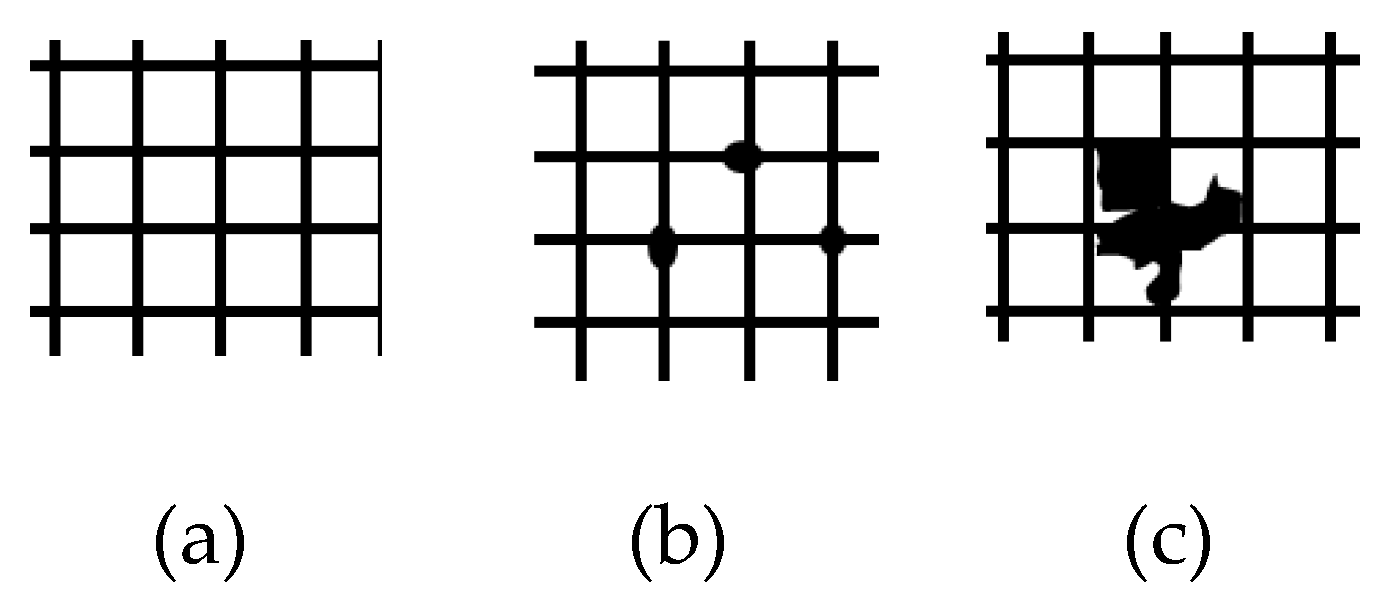


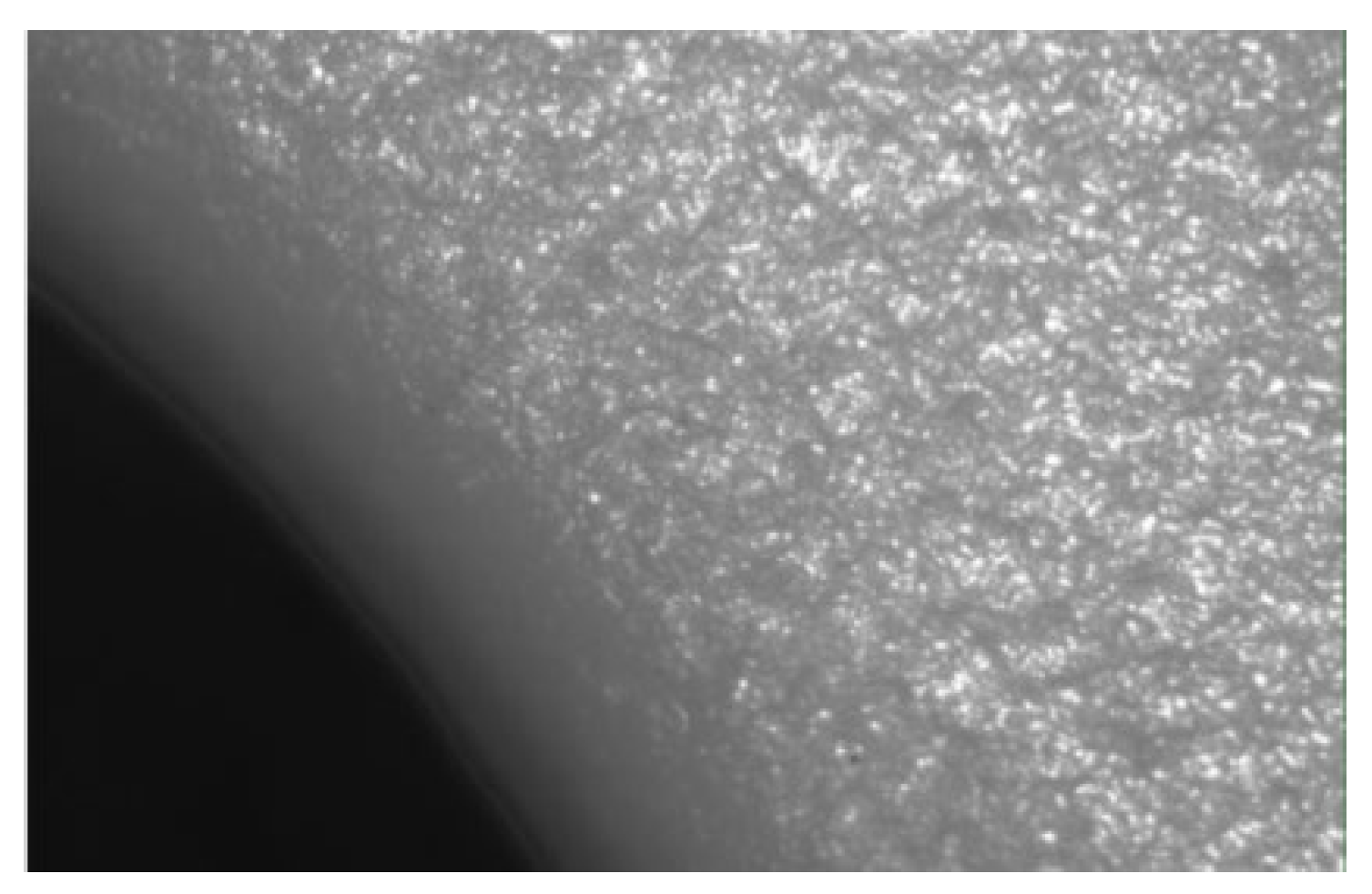
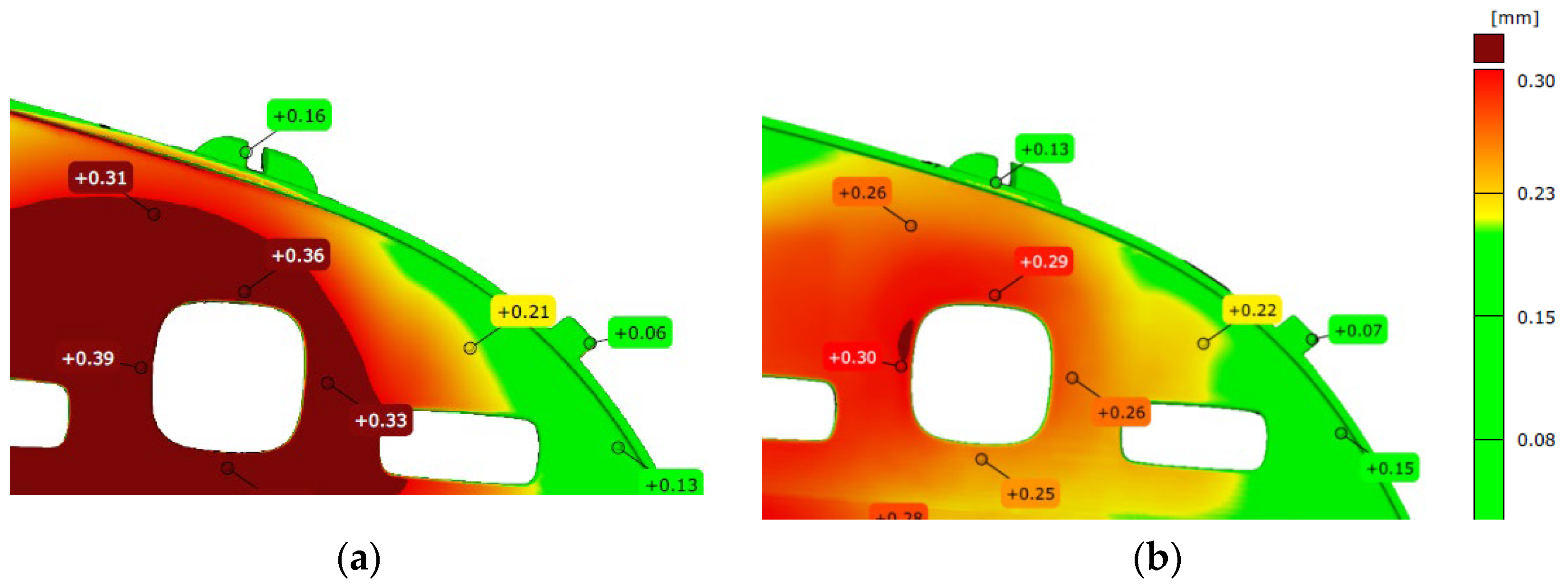
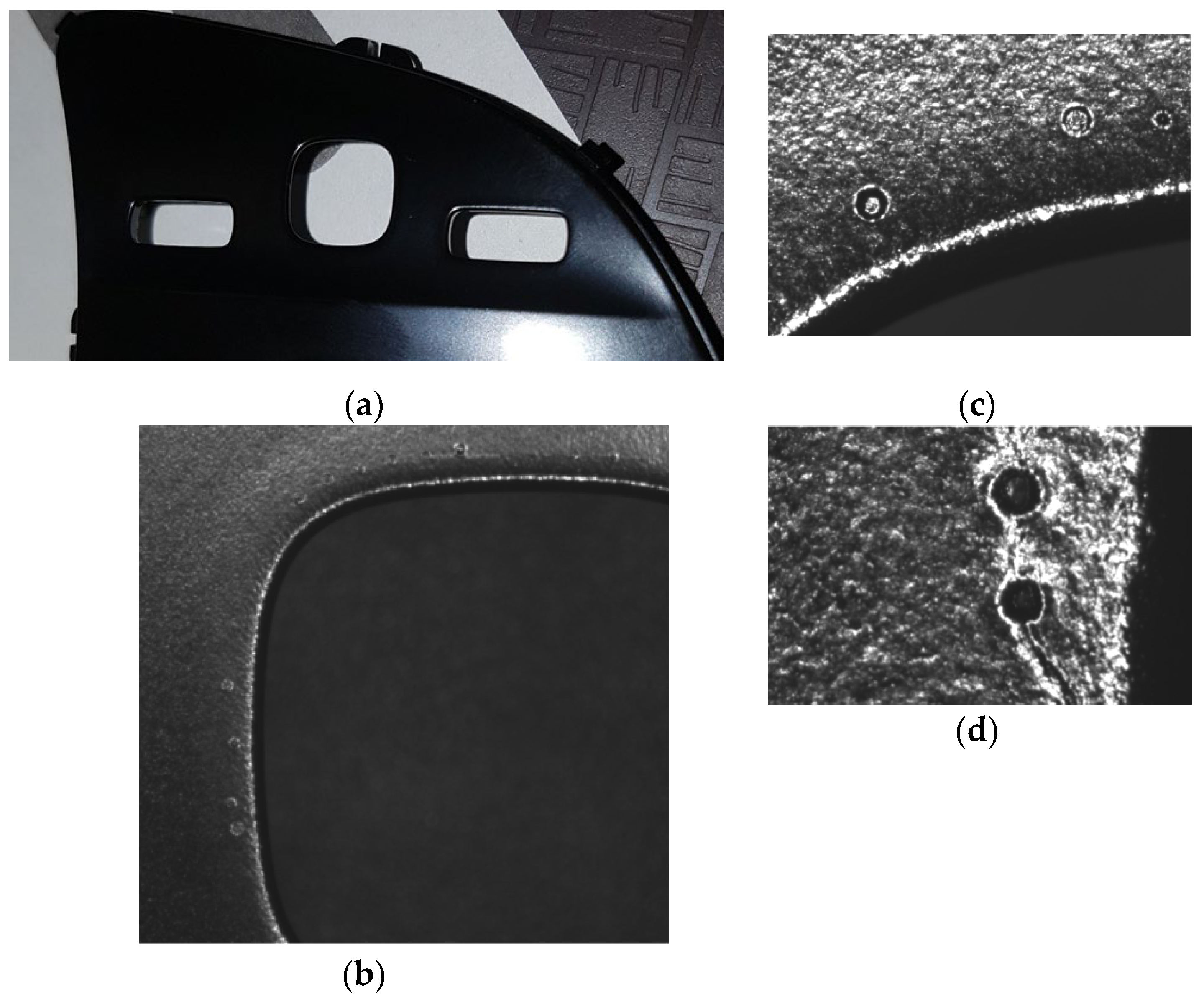
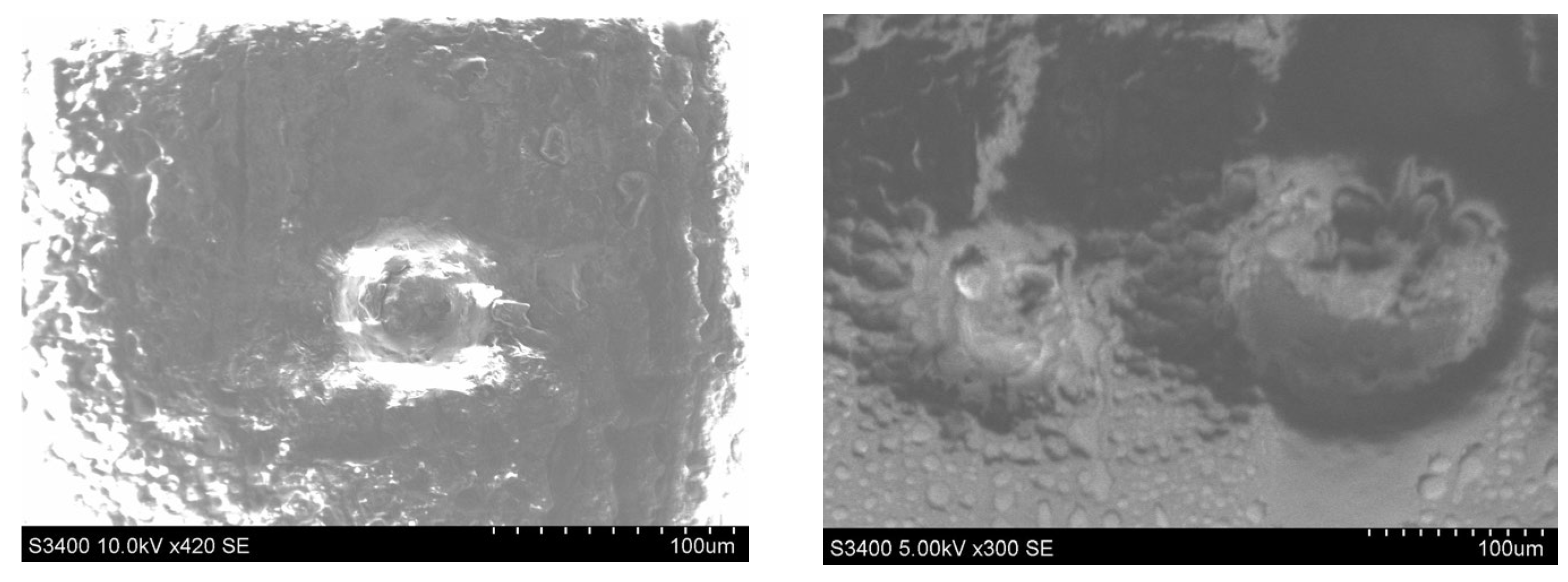


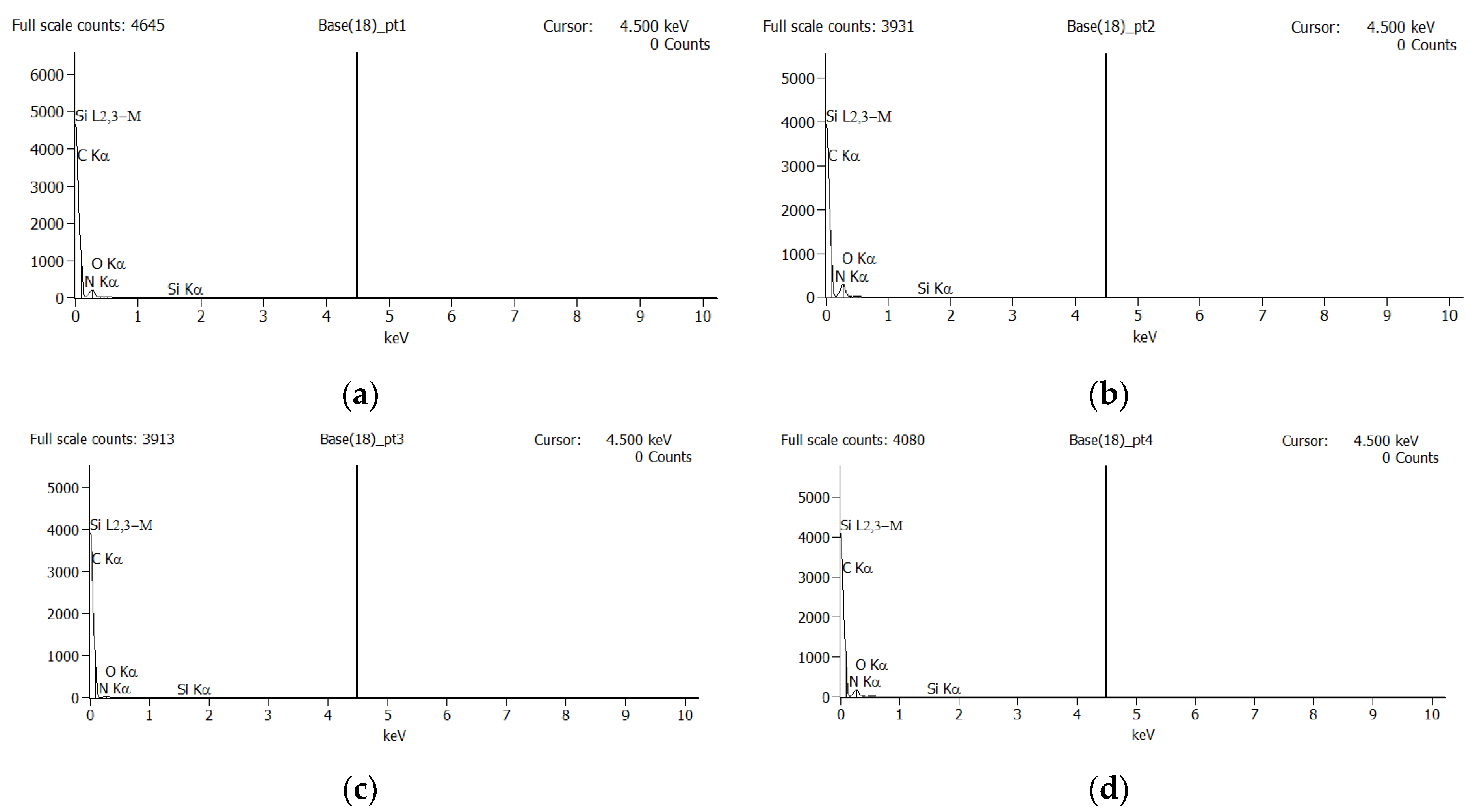




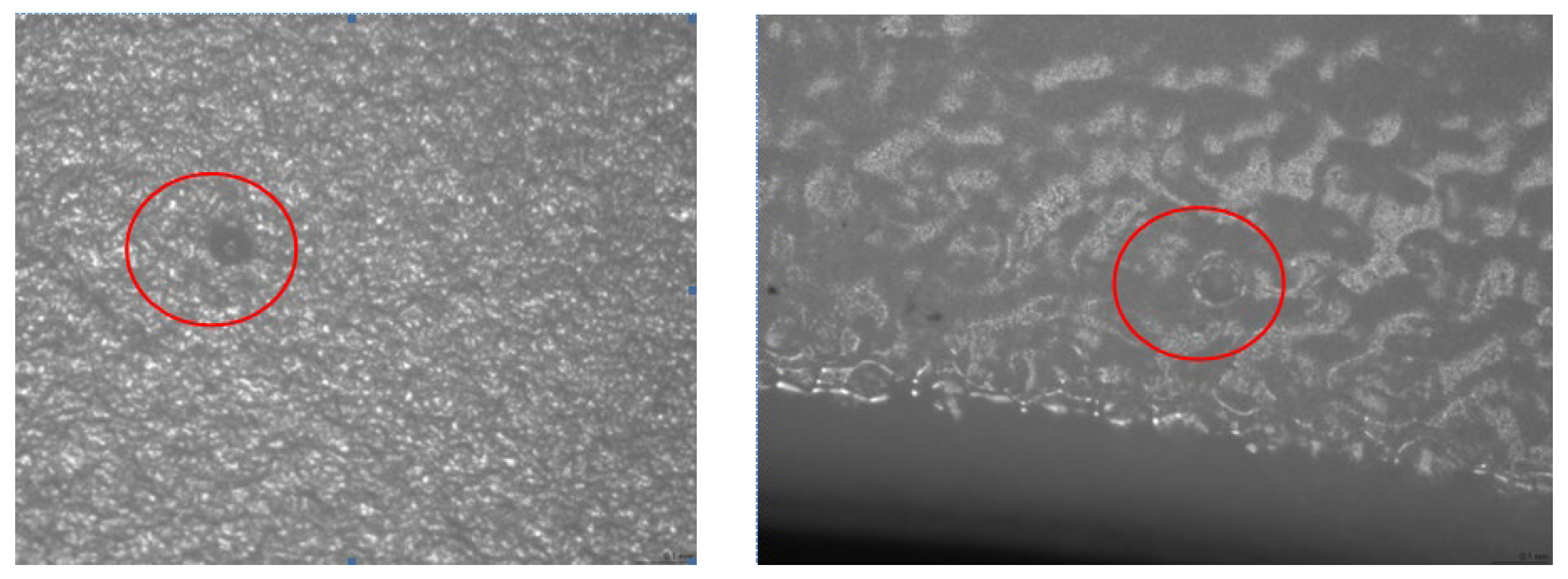
| Levels | Mold Temp | Mold Pressure | 3D Shape | Surface Tension | Primer Thickness | Laser Current | Clear CoatThickness | UV Power |
|---|---|---|---|---|---|---|---|---|
| °C | bar | mm | mN/m | micron | A | micron | % | |
| Level 1 | 65 | 825 | 0.1 | 30 | 16 | 60 | 28 | 30 |
| Level 2 | 70 | 830 | 0.2 | 32 | 18 | 70 | 30.5 | 37 |
| Level 3 | 80 | 835 | 0.3 | 35 | 20 | 80 | 32 | 45 |
| No. | To Do | How Many? | Result | Remarks |
|---|---|---|---|---|
| 1 | Surface tension test by Dyne pens | 8 frames | The affected area is for 30 mN/m, and the good one is for 35 mN/m | Each frame with 2 × 2 cavities out of 8 cavities |
| 2 | Visual test: sink marks, scratches—on injected parts | 8 frames | All parts OK, no defects detected | Each frame with 2 × 2 cavities out of 8 cavities |
| 3 | Microscopic optical test: pin holes, fish-eyes—on injected parts | 8 frames | All parts OK, no defects detected | Each frame with 2 × 2 cavities out of 8 cavities |
| 4 | Scan 3D GOM each cavity out of 8 cavities | 3 × 8 cavities | Cavities 3, 4, 5, and 6 have been observed with bigger deformations compared with the ones from the cavities 1,2, 7, and 8 | One for each cavity was measured in GOM 3D |
| 5 | Adhesion test | 3 parts | Nothing detected, Level 1 | Each frame with two cavities out of 8 cavities |
| 6 | Thickness test | 4 metallic plates | The thickness in tolerance field, average of 17 microns | |
| 7 | Visual test: orange peel, scratches, inclusions, pin holes after the black primer coating | 8 frames | 1 pc. Not OK—inclusions due to contamination | Not linked with the fish-eye defect |
| 8 | Microscopic optical test: fish-eyes—after the black primer coating | 8 frames | 6 pcs. Not OK—fish-eye present in the rectangle window area | |
| 9 | Electron microscope with EDX test: material components | 5 pcs. | Results presented in the separate chapter | |
| 10 | Visual test: incomplete coating removal—after laser engraving | 8 frames | No issues detected | |
| 11 | Microscopic optical test: cut edge failures after laser engraving | 8 frames | 1 pc. Not OK—“fish-eye” defect present near the engraved symbol | |
| 12 | Thickness test | 4 metallic plates | The thickness in tolerance field, average of 31 microns | |
| 13 | Microscopic optical test: fish-eyes, after the UV-cured transparent coat | 8 frames | 3 pcs. Not OK—fish-eye present in the rectangle window area |
| Net Counts | Weight % | Atom % | ||||||||||
|---|---|---|---|---|---|---|---|---|---|---|---|---|
| C-K | N-K | O-K | Si-K | C-K | N-K | O-K | Si-K | C-K | N-K | O-K | Si-K | |
| Pt1 | 1840 | 335 | 205 | 3 | 41.37 | 46.86 | 11.56 | 0.21 | 45.80 | 44.49 | 9.61 | 0.10 |
| Pt2 | 2566 | 393 | 177 | 3 | 45.79 | 45.94 | 8.12 | 0.15 | 50.13 | 43.13 | 6.67 | 0.07 |
| Pt3 | 197 | 130 | 73 | 0 | 19.61 | 62.59 | 17.80 | 0.00 | 22.64 | 61.94 | 15.42 | 0.00 |
| Pt4 | 1589 | 332 | 190 | 0 | 38.94 | 49.34 | 11.72 | 0.00 | 43.25 | 46.99 | 9.77 | 0.00 |
| Level | Mold Temp | Mold Pressure | 3D Shape | Surface Tension | Primer Thickness | Laser Current | Clear Coat Thickness | UV Power |
|---|---|---|---|---|---|---|---|---|
| 1 | −1338 | −2398 | −4127 | −4519 | −3181 | −1729 | −4127 | −4519 |
| 2 | −1729 | −3736 | −3850 | −3458 | −3458 | −2398 | −3181 | −2121 |
| 3 | −7308 | −4241 | −2398 | −2398 | −3736 | −6248 | −3067 | −3736 |
| Delta | 5970 | 1843 | 1729 | 2121 | 0555 | 4519 | 1060 | 2398 |
| Rank | 1 | 5 | 6 | 4 | 8 | 2 | 7 | 3 |
Publisher’s Note: MDPI stays neutral with regard to jurisdictional claims in published maps and institutional affiliations. |
© 2022 by the authors. Licensee MDPI, Basel, Switzerland. This article is an open access article distributed under the terms and conditions of the Creative Commons Attribution (CC BY) license (https://creativecommons.org/licenses/by/4.0/).
Share and Cite
Braga, I.C.; Udroiu, R.; Nedelcu, A. Novel Method for Failure Modes Detection in UV-Cured Clear Coated Polymer for Automotive Interior Mechatronic Devices. Polymers 2022, 14, 3811. https://doi.org/10.3390/polym14183811
Braga IC, Udroiu R, Nedelcu A. Novel Method for Failure Modes Detection in UV-Cured Clear Coated Polymer for Automotive Interior Mechatronic Devices. Polymers. 2022; 14(18):3811. https://doi.org/10.3390/polym14183811
Chicago/Turabian StyleBraga, Ion Cristian, Razvan Udroiu, and Anisor Nedelcu. 2022. "Novel Method for Failure Modes Detection in UV-Cured Clear Coated Polymer for Automotive Interior Mechatronic Devices" Polymers 14, no. 18: 3811. https://doi.org/10.3390/polym14183811
APA StyleBraga, I. C., Udroiu, R., & Nedelcu, A. (2022). Novel Method for Failure Modes Detection in UV-Cured Clear Coated Polymer for Automotive Interior Mechatronic Devices. Polymers, 14(18), 3811. https://doi.org/10.3390/polym14183811








